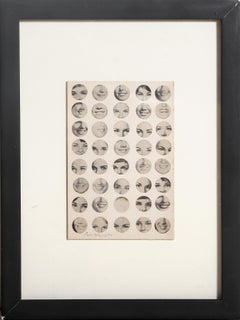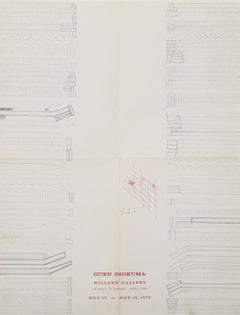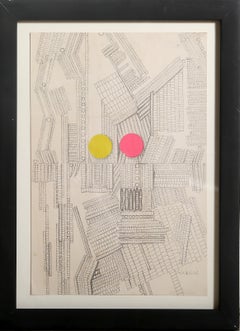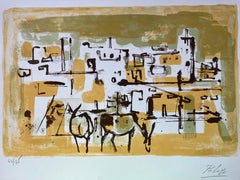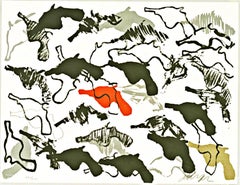Genichiro Inokuma Art
to
3
Overall Width
to
Overall Height
to
3
1
2
3
1
1
1
1
1
3
10,046
2,764
1,381
1,375
2
1
3
Artist: Genichiro Inokuma
Faces, Conceptual Collage on Board by Genichiro Inokuma
By Genichiro Inokuma
Located in Long Island City, NY
Genichiro Inokuma, Japanese (1902 - 1993) - Faces, Year: 1970, Medium: Collage on board, signed and dated in pencil, Size: 6 x 4 in. (15.24 x 10.1...
Category
1970s Conceptual Genichiro Inokuma Art
Materials
Mixed Media
Exhibition Poster, Conceptual Poster with Pen Drawing by Genichiro Inokuma
By Genichiro Inokuma
Located in Long Island City, NY
Genichiro Inokuma, Japanese (1902 - 1993) - Exhibition Poster, Year: 1968, Medium: Poster, with pen drawing, signed and dated in the plate, Size: ...
Category
1960s Conceptual Genichiro Inokuma Art
Materials
Pen, Offset
Fault Lines, Conceptual Lithograph by Genichiro Inokuma
By Genichiro Inokuma
Located in Long Island City, NY
Genichiro Inokuma, Japanese (1902 - 1993) - Fault Lines, Year: circa 1970, Medium: Lithograph, signed in the plate lower right, Size: 9.5 x 6.5 in...
Category
1970s Conceptual Genichiro Inokuma Art
Materials
Lithograph
Related Items
"Untitled Abstract Village with Horses, Color Lithograph, 20th Century"
Located in Belgrade, MT
This piece is from my private collection of 20th Century -21st Century artists, many of which are from the School of Paris era. Pelayo produced this lithograph in colors. The Latin American spirit...
Category
Late 20th Century Conceptual Genichiro Inokuma Art
Materials
Paint, Lithograph
$320 Sale Price
20% Off
H 11 in W 17 in
Boom Boom (Guns) mid century print, New York International portfolio S/N 1960s
By Arman
Located in New York, NY
Arman
Boom Boom (unique variation from New York International Portfolio), 1965
Screenprint with pencil additions.
Pencil signed and numbered 12/225 on the front
Published by Chiron ...
Category
1960s Pop Art Genichiro Inokuma Art
Materials
Screen
Nature Morte
By (circle of) Pierre Ambrogiani
Located in Belgrade, MT
This colorful lithograph is part of my private collection.
It is a limited edition , 1 print available, signed and numbered 25/150. It is in very good condition. Vibrant and colorful.
Category
Mid-20th Century Abstract Expressionist Genichiro Inokuma Art
Materials
Lithograph
"Untitled 4.20" Chess Photography 24' x 35' in Edition of 10 by García De Marina
By García De Marina
Located in Culver City, CA
"Untitled 4.20" Chess Photography 24' x 35' in Edition of 10 by García De Marina
García de Marina was born in Gijón (Spain) in 1975. He emerged thr...
Category
21st Century and Contemporary Conceptual Genichiro Inokuma Art
Materials
Digital Pigment
$2,350
H 24 in W 35 in D 0.1 in
GEL Armoires Frigorifiques Commerciales horizontal mid century vintage poster
By Omnes
Located in Spokane, WA
Delightful 1950s French Refrigerator Poster — “Armoires Frigorifiques Commerciales GEL” — Linen Backed, Original! Grade A, Å- condition. Very fine!
Searching for the coolest piec...
Category
1950s Conceptual Genichiro Inokuma Art
Materials
Lithograph
$798 Sale Price
20% Off
H 30 in W 46 in D 0.05 in
A Device for Converting a Chilling Underground Wind into Memory Signed/N Print
Located in New York, NY
Dennis Oppenheim
A Device for Converting a Chilling Underground Wind into Memory, 1986
Lithograph
Hand signed, numbered 3/100 and dated on lower front
38 1/5 × 50 inches
Unframed
P...
Category
1980s Conceptual Genichiro Inokuma Art
Materials
Lithograph
untitled, color abstract, original lithograph
Located in Belgrade, MT
This piece is part of my private collection of 20th Century artists that were part of the School of Paris era. This piece is original and signed by Pelayo and numbered.
Category
Late 20th Century Conceptual Genichiro Inokuma Art
Materials
Paint, Acrylic, Lithograph
$320 Sale Price
20% Off
H 16 in W 11 in
Monograph, Hand Signed by Francesco Clemente and inscribed with a small drawing
By Francesco Clemente
Located in New York, NY
Francesco Clemente
Clemente (Hand Signed by Francesco Clemente and inscribed with a small drawing), 1998
Large Illustrated Softback Exhibition Catalogue. (Hand signed and inscribed t...
Category
1990s Contemporary Genichiro Inokuma Art
Materials
Paper, Ink, Mixed Media, Lithograph, Offset
$880
H 11.7 in W 10 in D 2 in
An Interior Language I
Located in New York, NY
About the Series:
Gilliam began the series Life Lines in 2017 after recently coming into possession of MRI scans of her brain. The scans, which she spent hours pouring over, both fas...
Category
2010s Genichiro Inokuma Art
Materials
Etching, Aquatint, Photographic Paper, Photogram
Monotype w/hand painting, geometric art famed color field painter, signed Framed
By Kenneth Noland
Located in New York, NY
Kenneth Noland
Untitled, 1987
Monotype with hand painting on wove paper
Signed and dated in pencil on the reverse, with the artist's initials blind stamped lower right
Unique
Frame i...
Category
1980s Color-Field Genichiro Inokuma Art
Materials
Acrylic, Monotype, Screen
Kenneth NolandMonotype w/hand painting, geometric art famed color field painter, signed Framed, 1987
$20,000
H 43 in W 31.25 in D 1 in
Abstract Expressionist monotype (unique), signed and inscribed with heart Framed
By Robert Natkin
Located in New York, NY
Robert Natkin
monotype (unique) on paper
signed in marker on the front
Pencil signed, and inscribed with heart doodle:
"For Dorothy and Arthur with my Love Natkin"
Provenance: collec...
Category
1970s Abstract Genichiro Inokuma Art
Materials
Monotype
$7,500
H 24 in W 35 in D 2 in
Flora and Fauna Silkscreen
By Michail Grobman
Located in Surfside, FL
Shipping will be a bit longer as this piece is located in Israel
Michail Grobman, Israeli, born in Soviet Union, 1939.
Michail Grobman was born in Moscow. He grew up writing poetry...
Category
1980s Conceptual Genichiro Inokuma Art
Materials
Lithograph
Genichiro Inokuma art for sale on 1stDibs.
Find a wide variety of authentic Genichiro Inokuma art available for sale on 1stDibs. You can also browse by medium to find art by Genichiro Inokuma in lithograph, mixed media, offset print and more. Not every interior allows for large Genichiro Inokuma art, so small editions measuring 4 inches across are available. Genichiro Inokuma art prices can differ depending upon medium, time period and other attributes. On 1stDibs, the price for these items starts at $600 and tops out at $3,000, while the average work can sell for $1,500.
